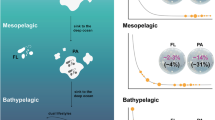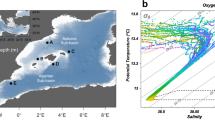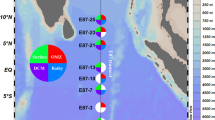Abstract
In this work, we study the diversity of bathypelagic microbial eukaryotes (0.8–20 μm) in the global ocean. Seawater samples from 3000 to 4000 m depth from 27 stations in the Atlantic, Pacific and Indian Oceans were analyzed by pyrosequencing the V4 region of the 18S ribosomal DNA. The relative abundance of the most abundant operational taxonomic units agreed with the results of a parallel metagenomic analysis, suggesting limited PCR biases in the tag approach. Although rarefaction curves for single stations were seldom saturated, the global analysis of all sequences together suggested an adequate recovery of bathypelagic diversity. Community composition presented a large variability among samples, which was poorly explained by linear geographic distance. In fact, the similarity between communities was better explained by water mass composition (26% of the variability) and the ratio in cell abundance between prokaryotes and microbial eukaryotes (21%). Deep diversity appeared dominated by four taxonomic groups (Collodaria, Chrysophytes, Basidiomycota and MALV-II) appearing in different proportions in each sample. Novel diversity amounted to 1% of the pyrotags and was lower than expected. Our study represents an essential step in the investigation of bathypelagic microbial eukaryotes, indicating dominating taxonomic groups and suggesting idiosyncratic assemblages in distinct oceanic regions.
Similar content being viewed by others
Log in or create a free account to read this content
Gain free access to this article, as well as selected content from this journal and more on nature.com
or
References
Acinas S, Sarma-Rupavtarm R, Klepac-Ceraj V, Polz M . (2005). PCR-induced sequence artifacts and bias: insights from comparison of two 16S rRNA clone libraries constructed from the same sample. Appl Environ Microbiol 71: 8966.
Agogué H, Brink M, Dinasquet J, Herndl GJ . (2008). Major gradients in putatively nitrifying and non-nitrifying Archaea in the deep North Atlantic. Nature 456: 788–791.
Agusti S, Gonzalez-Gordillo JI, Vaque D, Estrada M, Cerezo MI, Salazar G et al. (2015). Ubiquitous healthy diatoms in the deep sea confirm deep carbon injection by the biological pump. Nat Commun 6: e-pub ahead of print 9 July 2015; doi:10.1038/ncomms8608.
Angel MV . (1993). Biodiversity of the Pelagic ocean. Conserv Biol 7: 760–772.
Arístegui J, Gasol JM, Duarte CM, Herndl GJ . (2009). Microbial oceanography of the dark ocean’s Pelagic realm. Limnol Oceanogr 54: 1501–1529.
Azam F, Fenchel T, Field J, Gray J, Meyer-Reil L, Thingstad F . (1983). The ecological role of water-column microbes in the sea. Mar Ecol Prog Ser 10: 257–263.
Bass D, Howe A, Brown N, Barton H, Demidova M, Michelle H et al. (2007). Yeast forms dominate fungal diversity in the deep oceans. Proc R Soc B 274: 3069–3077.
Caporaso JG, Kuczynski J, Stombaugh J, Bittinger K, Bushman FD, Costello EK et al. (2010). QIIME allows analysis of high-throughput community sequencing data. Nat Meth 7: 335–336.
Catalá TS, Reche I, Fuentes-Lema A, Romera-Castillo C, Nieto-Cid M, Ortega-Retuerta E et al. (2015). Turnover time of fluorescent dissolved organic matter in the dark global ocean. Nat Commun 6: 5986.
Charvet S, Vincent WF, Comeau AM, Lovejoy C . (2012). Pyrosequencing analysis of the protist communities in a High Arctic meromictic lake: DNA preservation and change. Front Microbiol 3: 422.
Clarke KR, Ainsworth M . (1993). A method of linking multivariate community structure to environmental variables. Mar Ecol Prog Ser 92: 205–219.
Coats DW, Park MG . (2002). Parasitism of photosynthetic dinoflagellates by three strains of Amoebophyra (Dinophyta): parasite survival, infectivity, generation time and host specificity. J Phycol 38: 520–528.
Countway PD, Gast RJ, Dennet MR, Savai P, Rose JM, Caron DA . (2007). Distinct protistan assemblages characterize the euphotic zone and deep sea (2500 m) of the western North Atlantic (Sargasso Sea and Gulf Stream). Environ Microbiol 9: 1219–1232.
del Campo J, Massana R . (2011). Emerging diversity within chrysophytes, choanoflagellates and bicosoecids based on molecular surveys. Protist 162: 435–448.
Duarte CM . (2015). Seafaring in the 21st century: the Malaspina 2010 Circumnavigation Expedition. Limnol Oceanogr Bull 24: 11–14.
Edgar RC . (2010). Search and clustering orders of magnitude faster than BLAST. Bioinformatics 26: 2460–2461.
Edgar RC, Haas BJ, Clemente JC, Quince C, Knight R . (2011). UCHIME improves sensitivity and speed of chimera detection. Bioinformatics 27: 2194–2200.
Edgcomb V, Kysela D, Teske A, de Vera Gomez A, Sogin M . (2002). Benthic eukaryotic diversity in the Guaymas Basin hydrothermal vent environment. Proc Natl Acad Sci USA 99: 7658–7662.
Edgcomb V, Beaudoin D, Gast R, Biddle JF, Teske A . (2011a). Marine subsurface eukaryotes: the fungal majority. Environ Microbiol 13: 172–183.
Edgcomb V, Orsi W, Bunge J, Jeon S, Christen R, Leslin C et al. (2011b). Protistan microbial observatory in the Cariaco basin, Caribbean. I. Pyrosequencing vs Sanger insights into species richness. ISME J 5: 1344–1356.
Galand PE, Casamayor EO, Kirchman DL, Lovejoy C . (2009). Ecology of the rare microbial biosphere of the Arctic Ocean. Proc Natl Acad Sci USA 106 (52): 22427–22432.
Guillou L, Bachar D, Audic S, Bass D, Berney C, Bittner L et al. (2013). The protist ribosomal reference database (PR2): a catalog of unicellular eukaryote small sub-unit rRNA sequences with curated taxonomy. Nucleic Acids Res 41: 597–604.
Hansell DA, Carlson CA, Repeta DJ, Schlitzer R . (2009). Dissolved organic matter in the ocean: a controversy stimulates new insights. Oceanography 22: 202–211.
Hamme RC, Emerson SR . (2013). Deep-sea nutrient loss inferred from the marine dissolved N2/Ar ratio. Geophys Res Lett 40: 1149–1153.
Holen DA, Boraas ME . (1996) Mixotrophy in chrysophytes. In:Craig D, Sandgren CD, Smol JP, Kristiansen J (eds.) Chrysophyte Algae Ecology, Phylogeny and Development. University Press: Leiden, 1996: pp 119–140.
Ishitani Y, Ujiié Y, de Vargas C, Not F, Takahashi K . (2012). Phylogenetic relationships and evolutionary patterns of the order Collodaria (Radiolaria). PLoS One 7: e35775.
Kilias E, Wolf C, Nöthig E-M, Peeken I, Metfies K . (2013). Protist distribution in the Western Fram Strait in summer 2010 based on 454-pyrosequencing of 18S rDNA. J Phycol 49: 996–1010.
Kirchman DL, Cottrell MT, Lovejoy C . (2010). The structure of bacterial communities in the western Arctic ocean as revealed by pyrosequencing of 16S rRNA genes. Environ Microbiol 12: 1132–1143.
Lara E, Moreira D, Vereshchaka A, López-García P . (2009). Pan-oceanic distribution of new highly diverse clades of deep-sea diplonemids. Environ Microbiol 11: 47–55.
Logares R, Audic S, Santini S, Pernice MC, de Vargas C, Massana R . (2012). Diversity patterns and activity of uncultured marine heterotrophic flagellates unveiled with pyrosequencing. ISME J 6: 1823–1833.
Logares R, Sunagawa S, Salazar G, Cornejo-Castillo FM, Ferrera I, Sarmento H et al. (2014). Metagenomic 16S rDNA Illumina tags are a powerful alternative to amplicon sequencing to explore diversity and structure of microbial communities. Environ Microbiol 16: 2659–2671.
López-García P, Rodríguez-Valera F, Pedrós-Alió C, Moreira D . (2001). Unexpected diversity of small eukaryotes in deep-sea Antarctic plankton. Nature 409: 603–607.
Margulies M, Egholm M, Altman W, Attiya S, Bader J, Bemben L et al. (2005). Genome sequencing in microfabricated high-density picolitre reactors. Nature 437: 376–380.
Massana R, Pedrós-Alió C . (2008). Unveiling new microbial eukaryotes in the surface ocean. Curr Opin Microbiol 11: 213–218.
Massana R . (2011). Eukaryotic picoplankton in surface oceans. Annu Rev Microbiol 65: 1–47.
Massana R, del Campo J, Sieracki ME, Audic S, Logares R . (2014). Exploring the uncultured microeukaryote majority in the oceans: reevaluation of ribogroups within stramenopiles. ISME J 8: 854–866.
Massana R, Logares R . (2013). Eukaryotic versus prokaryotic marine picoplankton ecology. Environ Microbiol 15: 1254–1261.
Massana R, Gobet A, Audic S, Bass D, Bittner L, Boutte C et al. (2015). Marine protist diversity in European coastal waters and sediments as revealed by high-throughput sequencing. Environ Microbiol e-pub ahead of print 28 June 2015; doi:10.1111/1462-2920.12955.
Michaels AF, Silver MW . (1988). Primary production, sinking fluxes and the microbial food web. Deep Sea Res I 35: 473–490.
Moon-van der Staay SY, De Wachter R, Vaulot D . (2001). Oceanic 18S rDNA sequences from picoplankton reveal unsuspected eukaryotic diversity. Nature 409: 607–610.
Morgan-Smith D, Herndl GJ, van Aken HM, Bochdansky AB . (2011). Abundance of eukaryotic microbes in the deep subtropical North Atlantic. Aquat Microb Ecol 65: 103–115.
Morgan-Smith D, Clouse MA, Herndl GJ, Bochdansky AB . (2013). Diversity and distribution of microbial eukaryotes in the deep tropical and subtropical North Atlantic Ocean. Deep Sea Res I 78: 58–69.
Nagata T, Tamburini C, Arístegui J, Baltar F, Bochdansky AB, Fonda-Umani S et al. (2010). Emerging concepts on microbial processes in the bathypelagic ocean – ecology, biogeochemistry, and genomics. Deep Sea Res II 57: 1519–1536.
Not F, Gausling R, Azam F, Heidelberg JF, Worden AZ . (2007). Vertical distribution of picoeukaryotic diversity in the Sargasso Sea. Environ Microbiol 9: 1233–1252.
Not F, del Campo J, Balagué V, de Vargas C, Massana R . (2009). New Insights into the Diversity of Marine Picoeukaryotes. PLoS ONE 4: e7143.
Oksanen J, Blanchet FG, Kindt R, Legendre P, Minchin PR, O'Hara RB et al. (2013), Vegan: Community Ecology Package. R package version 2.0-7 http://CRAN.R-project.org/package=vegan.
Orsi W, Biddle JF, Edgcomb V . (2013). Deep sequencing of subseafloor eukaryotic rRNA reveals active fungi across marine subsurface provinces. PLoS One 8: e56335.
Pawlowski J, Christen R, Lecroq B, Bachar D, Shahbazkia HR, Amaral-Zettler L et al. (2011). Eukaryotic richness in the Abyss: insights from pyrotag sequencing. PLoS One 6: e18169.
Pernice MC, Logares R, Guillou L, Massana R . (2013). General patterns of diversity in major marine microeukaryote lineages. PLoS One 8: e57170.
Pernice MC, Forn I, Gomes A, Lara E, Alonso-Saez L, Arrieta JM et al. (2015). Global abundance of planktonic heterotrophic protists in the deep ocean. ISME J 9: 782–792.
Quast C, Pruesse E, Yilmaz P, Gerken J, Schweer T, Yarza P et al. (2013). The SILVA ribosomal RNA gene database project: improved data processing and web-based tools. Nucleic Acids Res 41: 590–596.
Sanders RW, Caron DA, Berninger UG . (1992). Relationships between bacteria and heterotrophic nanoplankton in marine and fresh waters: an inter-ecosystem comparison. Mar Ecol Prog Ser 86: 1–14.
Small HJ, Shields JD, Reece KS, Bateman K, Stentiford GD . (2012). Morpholmgical and molecular characterization of hematodinium perezi (Dinophyceae: Syndiniales), a Dinoflagellate parasite of the Harbour Crab, Liocarcinus depurator. J Euk Microbiol 59: 54–66.
Richards TA, Jones MDM, Leonard G, Bass D . (2012). Marine fungi: their ecology and molecular diversity. Annu Rev Mar Sci 4: 495–522.
Rodríguez-Martínez R, Labrenz M, del Campo J, Forn I, Jürgens K, Massana R . (2009). Distribution of the uncultured protist MAST-4 in the Indian Ocean, Drake Passage and Mediterranean Sea assessed by real-time quantitative PCR. Environ Microbiol 11: 397–408.
Salani FS, Arndt H, Hausmann K, Nitsche F, Scheckenbach F . (2012). Analysis of the community structure of abyssal kinetoplastids revealed similar communities at larger spatial scales. ISME J 6: 713–723.
Sauvadet A-L, Gobet A, Guillou L . (2010). Comparative analysis between protist communities from the deep-sea pelagic ecosystem and specific deep hydrothermal habitats. Environ Microbiol 12: 2946–2964.
Scheckenbach F, Hausmann K, Wylezich C, Weitere M, Arndt H . (2010). Large-scale patterns in biodiversity of microbial eukaryotes from the abyssal sea floor. Proc Natl Acad Sci USA 107: 115–120.
Stoeck T, Taylor G, Epstein S . (2003). Novel eukaryotes from a permanently anoxic Cariaco basin (Caribbean Sea). Appl Environ Microbiol 69: 5656–5663.
Stoeck T, Bass D, Nebel M, Christen R, Jones MDM, Breiner H-W et al. (2010). Multiple marker parallel tag environmental DNA sequencing reveals a highly complex eukaryotic community in marine anoxic water. Mol Ecol 19: 21–31.
Stoeck T, Zuendorf A, Breiner H-W, Behnke A . (2007). A Molecular Approach to Identify Active Microbes in Environmental Eukaryote Clone Libraries. Microb Ecol 53: 328–339.
Stoecker D, Johnson M, deVargas C, Not F . (2009). Acquired phototrophy in aquatic protists. Aquat Microb Ecol 57: 279–310.
Suzuki R, Shimodaira H . (2006). Pvclust: an R package for assessing the uncertainty in hierarchical clustering. Bioinformatics 22: 1540–1542.
Tanaka T, Rassoulzadegan F, Thingstad TF . (2005). Analyzing the trophic link between the mesopelagic microbial loop and zooplankton from observed depth profiles of bacteria and protozoa. Biogeosciences 2: 9–13.
Varela MM, Van Aken HM, Herndl GJ . (2008). Abundance and activity of Chloroflexi-type SAR202 bacterioplankton in the meso- and bathypelagic waters of the (sub)tropical Atlantic. Environ Microbiol 10: 1903–1911.
Wessel P, Smith WHF, Scharroo R, Luis J, Wobbe F . (2013). Generic mapping tools: improved version released. Eos Trans Am Geophys Union 94: 409–410.
Acknowledgements
This project was supported by the Spanish Ministry of Economy and Competitiveness through project Consolider-Ingenio Malaspina-2010 (CSD2008–00077) to CMD and FLAME (CGL2010-16304) to RM. RL was supported by a Juan de la Cierva Fellowship (JCI-2010-06594, Spanish Ministry of Economy and Competitiveness, Spain). Sequencing at the JGI was supported by US Department of Energy (DOE) JGI 2011 Microbes Program grant CSP 602 grant to SGA. The work conducted by the US Department of Energy Joint Genome Institute is supported by the Office of Science of the US Department of Energy under Contract No. DE-AC02-05CH11231. Additional funding was provided by the Spanish Ministry of Economy and Competitivity grant MALASPINOMICS (CTM2011-15461-E). The authors were also supported by the Generalitat de Catalunya Research Group grants 2014SGR/1179. We thank our colleagues Xose A. Álvarez-Salgado, Teresa S. Catalá, Guillem Salazar, Francisco Cornejo-Castillo, Encarna Borrull, Cristina Díez, Elena Lara, Irene Forn, Dolors Vaqué, Eugenio Fraile, Verónica Benitez, the crew and the chief scientists of the various cruises for helpful collaboration.
Author information
Authors and Affiliations
Corresponding authors
Ethics declarations
Competing interests
The authors declare no conflict of interest.
Additional information
Supplementary Information accompanies this paper on The ISME Journal website
Rights and permissions
About this article
Cite this article
Pernice, M., Giner, C., Logares, R. et al. Large variability of bathypelagic microbial eukaryotic communities across the world’s oceans. ISME J 10, 945–958 (2016). https://doi.org/10.1038/ismej.2015.170
Received:
Revised:
Accepted:
Published:
Issue date:
DOI: https://doi.org/10.1038/ismej.2015.170
This article is cited by
-
Beyond the limits of the unassigned protist microbiome: inferring large-scale spatio-temporal patterns of Syndiniales marine parasites
ISME Communications (2023)
-
Comparison of Deep-Sea Picoeukaryotic Composition Estimated from the V4 and V9 Regions of 18S rRNA Gene with a Focus on the Hadal Zone of the Mariana Trench
Microbial Ecology (2022)
-
Dinoflagellates alter their carbon and nutrient metabolic strategies across environmental gradients in the central Pacific Ocean
Nature Microbiology (2021)
-
High and specific diversity of protists in the deep-sea basins dominated by diplonemids, kinetoplastids, ciliates and foraminiferans
Communications Biology (2021)
-
Dinoflagellate-targeted PCR reveals highly abundant and diverse communities of parasitic dinoflagellates in and near Zhubi Reef, South China Sea
Coral Reefs (2021)



